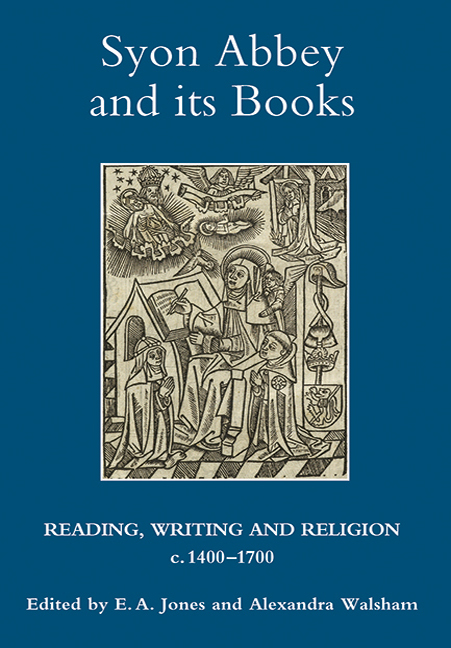Book contents
- Frontmatter
- Contents
- List of Illustrations
- Acknowledgments
- Notes on Contributors
- List of Abbreviations
- Syon Abbey: An Outline Chronology
- Introduction: Syon Abbey and its Books: Origins, Influences and Transitions
- I Brothers and Sisters
- 1 The Brothers of Syon, 1420–1695
- 2 Syon Abbey: Women and Learning c.1415–1600
- II Syon Abbey and the Book Trade
- III The Bridgettines in Exile
- IV History and Memory
- Appendix Syon Abbey's Books at the University of Exeter
- Index
- Miscellaneous Endmatter
2 - Syon Abbey: Women and Learning c.1415–1600
from I - Brothers and Sisters
Published online by Cambridge University Press: 09 May 2017
- Frontmatter
- Contents
- List of Illustrations
- Acknowledgments
- Notes on Contributors
- List of Abbreviations
- Syon Abbey: An Outline Chronology
- Introduction: Syon Abbey and its Books: Origins, Influences and Transitions
- I Brothers and Sisters
- 1 The Brothers of Syon, 1420–1695
- 2 Syon Abbey: Women and Learning c.1415–1600
- II Syon Abbey and the Book Trade
- III The Bridgettines in Exile
- IV History and Memory
- Appendix Syon Abbey's Books at the University of Exeter
- Index
- Miscellaneous Endmatter
Summary
Syon Abbey, founded by King Henry V in 1415, was the most important house for women religious established in England in the century before the Reformation. It was the only English house of Bridgettines, the Order of St Saviour, founded by St Bridget of Sweden (c.1303–73) as part of a contemporary movement for spiritual reform and renewal. Syon is renowned for its lavish endowment by Henry V, its principled opposition to Henry VIII's Reformation, and its significant role in forging recusant Catholic identity.
Learned Women
Syon is perhaps most famous in the fifteenth and sixteenth centuries as a centre of Renaissance learning and an intellectual powerhouse of ecclesiastical reform. From the mid-nineteenth century, when research on Syon began in earnest, it was not the sisters, who constituted the main body of the community, but the smaller group of brothers which attracted academic attention. Syon's reputation was glamorised by the association of its brothers with the charmed circle of English humanists who welcomed Erasmus in the early sixteenth century. Even The Angel of Syon, the only full-length biography of a member of the house, did not take one of the sisters as its subject, but the martyred brother St Richard Reynolds (d. 1535). The significance of the brothers’ contribution to national history, especially during the early stages of the English Reformation, made their lives the obvious starting point for research on the house. Documentary sources on them are plentiful as many of them were educated at Oxford and Cambridge universities and a number were the authors of surviving manuscripts and books.
The sisters remained the ‘still small voice of silence’ at the heart of the community. Their lives of dedication to contemplative prayer were the reason for its existence, but the details of their lives were veiled by their enclosure and a comparative lack of documentation. Over the last hundred years, information has gradually been accumulated and the lives of the nuns have come into focus. Research by manuscript scholars, notably Ann Hutchison, Christopher de Hamel, David Bell and Mary Erler, on books once owned by Syon's sisters has allowed a glimpse into their cloister.
- Type
- Chapter
- Information
- Syon Abbey and its BooksReading, Writing and Religion, c.1400-1700, pp. 82 - 103Publisher: Boydell & BrewerPrint publication year: 2010

